原标题:响应视窗属性动画 | 让您的软键盘动起来 (二)
在上一篇文章中,我们介绍了所有关于 “边到边” (edge-to-edge) 的 API 改动: 让您的软键盘动起来 。在这篇文章中,我们会继续跟进软键盘动画这一实际任务。为了展示可以实现的效果,您可以查看下面这个来自同一个应用的示例,左边的是运行在 Android 10 上,而右边的是运行在 Android 11 上 (动画效果是实际速度的 20%):
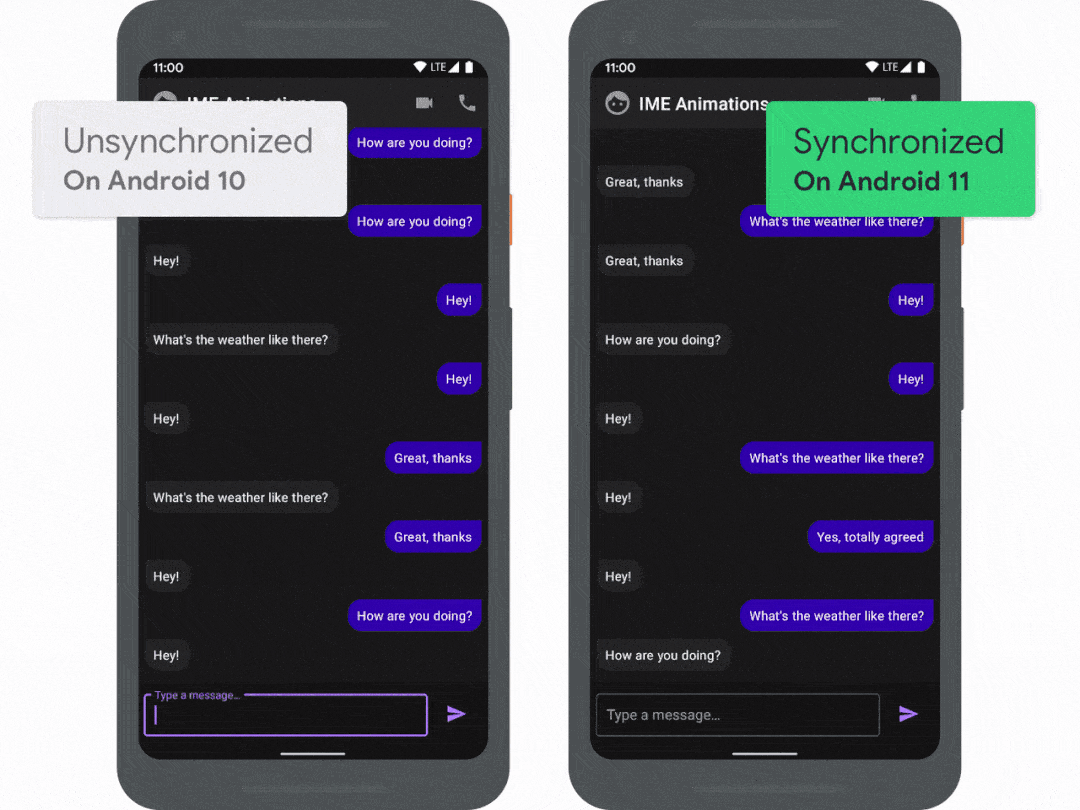
如上动图所示: 在 Android 10 以及以前版本的设备上,当用户点击文字输入框来输入回复,软键盘会带着动画效果移动到预期的位置,但是应用在两个状态间的动画很突兀。这是一个您在设备上已经看过很久的效果,降慢速度到实际速度的 20% 使得它更为明显。
您可以在右边看到相同的场景运行在 Android 11 上的效果。这一次,当用户点击文字输入框的时候,应用 跟随着软键盘一起移动并且创造了一个更流畅的体验。
所以您如何才能在您的应用中添加这种体验呢?这都依赖新 API 的支持…
- Android 11 https://developer.android.google.cn/android11
WindowInsetsAnimation 类
在 Android 11 中支持实现这种效果的 API 就是新的 WindowInsetsAnimation类,它包含一个涉及视窗属性的动画。应用可以通过 WindowInsetsAnimation.Callback类监听各种动画事件,这个回调可以被设置到一个视图上:
- WindowInsetsAnimation https://developer.android.google.cn/reference/android/view/WindowInsetsAnimation
- WindowInsetsAnimation.Callback https://developer.android.google.cn/reference/android/view/WindowInsetsAnimation.Callback
view.setWindowInsetsAnimationCallback(cb)
让我们来看一下这个回调类,以及它提供的方法:
想象一下当前软键盘是关闭的,用户刚刚点击了 EditText。系统现在马上要显示软键盘,由于我们已经设置了 WindowInsetsAnimation.Callback,我们会按顺序收到如下的调用:
overridefunonPrepare(animation: WindowInsetsAnimation) { // #1: 第一,onPrepare 被调用会允许应用记录当前布局的任何状态}
// #2: 在 onPrepare 之后,正常的 WindowInsets 会被下发到视图层次// 结构中,它包含了结束状态。这意味着您的视图的 // OnApplyWindowInsetsListener 会被调用,这会导致一个布局传递// 以反映结束状态
overridefunonStart(animation: WindowInsetsAnimation, bounds: WindowInsetsAnimation. Bounds): WindowInsetsAnimation.Bounds {
// #3: 接下来是 onStart ,这个会在动画开始的时候被调用。// 这允许应用记录下视图的目标状态或者结束状态returnbounds }
overridefunonProgress(insets: WindowInsets, runningAnimations: List< WindowInsetsAnimation> ): WindowInsets {
// #4: 接下来是一个很重要的调用:onProgress 。这个会在动画中每次视窗属性// 更改的时候被调用。在软键盘的这个例子中,这个调用会发生在软键盘在屏幕// 上滑动的时候。returninsets }
overridefunonEnd(animation: WindowInsetsAnimation) {
// #5: 最后 onEnd 在动画已经结束的时候被调用。使用这个来// 清理任何旧的状态。}}
这就是回调在理论上是如何工作的,现在让我们在场景中实践一下…
实现示例
我们会使用 WindowInsetsAnimation.Callback来实现在文章开头您看到的示例。让我们从实现我们的回调函数开始:
- WindowInsetsAnimation.Callback https://developer.android.google.cn/reference/android/view/WindowInsetsAnimation.Callback
onPrepare 方法
首先我们要复写 onPrepare,并且在其他布局改变发生 之前 记录下视图的 底部坐标:
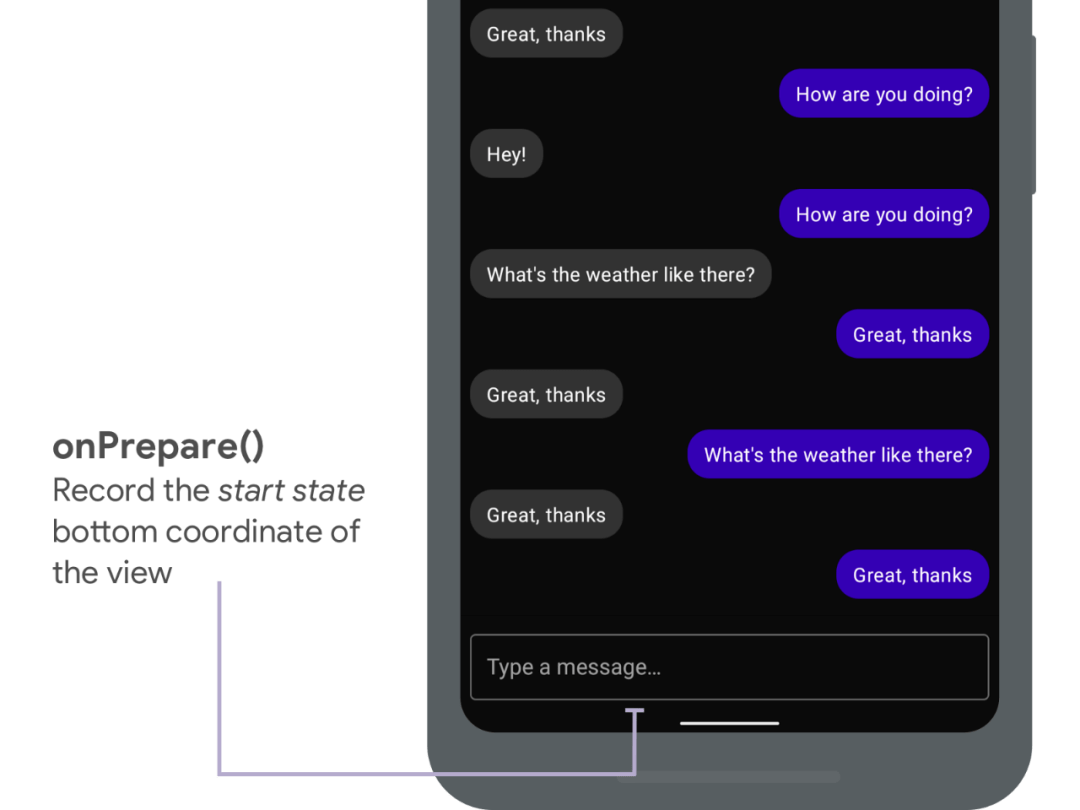
- onPrepare https://developer.android.google.cn/reference/android/view/WindowInsetsAnimation.Callback#onPrepare(android.view.WindowInsetsAnimation)
valcb = object: WindowInsetsAnimation.Callback(DISPATCH_MODE_STOP) { varstartBottom = 0varendBottom = 0
overridefunonPrepare(animation: WindowInsetsAnimation) { // #1: 首先 onPrepare 被调用,这允许应用记录下当前布局中的任何视图状态。// 我们要记录下这个视图在视窗中的底部坐标。startBottom = view.calculateBottomInWindow}}
属性分发
这时候结束状态的属性会被分发,而我们的 OnApplyWindowInsetsListener会被调用,监听器会更新容器视图的内边距,这会导致内容被推上去。
OnApplyWindowInsetsListener
https://developer.android.google.cn/reference/androidx/core/view/OnApplyWindowInsetsListener
OnApplyWindowInsetsListener
https://developer.android.google.cn/reference/androidx/core/view/OnApplyWindowInsetsListener
然而用户不会看到这个如下图所示的状态。
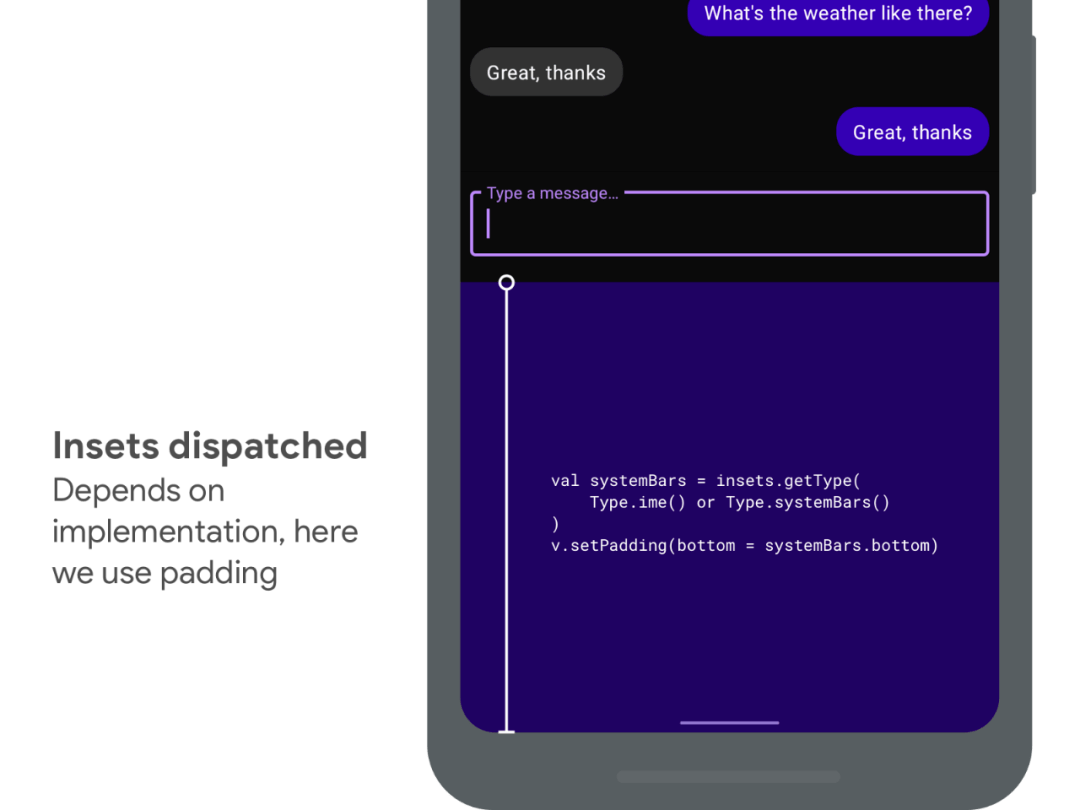
onStart 方法
接下来我们实现 onStart方法,这会让我们先记录下这个视图 结束时候的位置。
- onStart https://developer.android.google.cn/reference/android/view/WindowInsetsAnimation.Callback#onStart(android.view.WindowInsetsAnimation,%20android.view.WindowInsetsAnimation.Bounds)
我们利用 translationY在视觉上将视图移动回初始位置,因为我们不想现在就让用户看到结束状态。由于系统保证了任何由视窗属性变更导致的重新布局都会在 onStart的同一帧被调用,所以用户此时不会看到闪动。
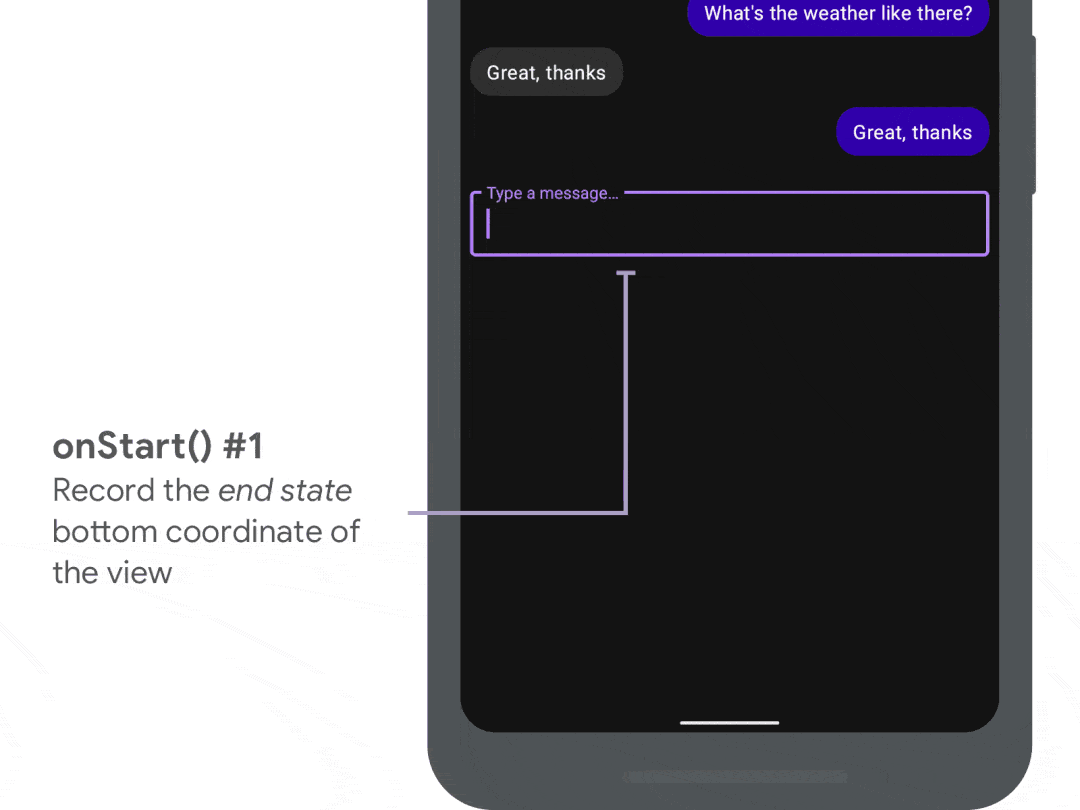
valcb = object: WindowInsetsAnimation.Callback(DISPATCH_MODE_STOP) { varstartBottom = 0varendBottom = 0
overridefunonStart(animation: WindowInsetsAnimation, bounds: WindowInsetsAnimation. Bounds): WindowInsetsAnimation.Bounds { // #3: 接下来是 onStart,它会在动画开始的时候被调用 // 我们记录下视窗中视图的底部endBottom = view.calculateBottomInWindow// 然后我们移动视图回到它视觉上的初始位置view.translationY = startBottom – endBottom// 我们不会更改边界,所以我们会返回传入的边界值returnbounds }}
onProgress 方法
最后我们要复写 onProgress方法,这会让我们可以在软键盘滑入的时候更新我们的视图。
- onProgress https://developer.android.google.cn/reference/android/view/WindowInsetsAnimation.Callback#onProgress(android.view.WindowInsets,%20java.util.List%3Candroid.view.WindowInsetsAnimation%3E)
我们会在起始和结束状态之间插值,并再次使用 translationY使得视图可以和软键盘一起移动。
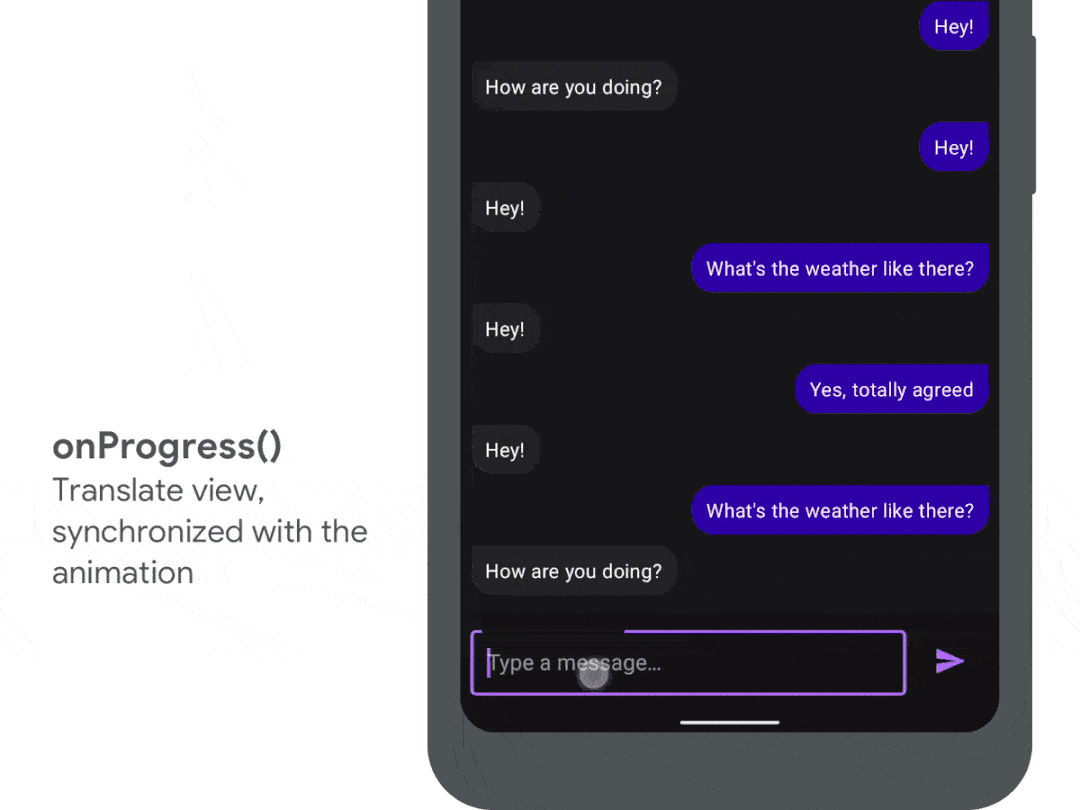
valcb = object: WindowInsetsAnimation.Callback(DISPATCH_MODE_STOP) { varstartBottom = 0varendBottom = 0
overridefunonProgress(insets: WindowInsets, runningAnimations: List< WindowInsetsAnimation> ): WindowInsets {
// #4: 接下来是最重要的调用:onProgress// 它会在动画中每次视窗属性改变的时候被调用。
// 从起始位置到结束位置,我们利用线性插值的方式和动画本身的分数// 来计算视图的偏移量。valoffset = lerp( startBottom – endBottom,0, animation.interpolatedFraction)// … 然后我们再用 translationY 来设置view.translationY = offset
returninsets }}
软键盘的协同效果
使用这个方法,我们已经实现了软键盘和应用视图的同步。如果您想查看完整的实现,请查阅 WindowInsetsAnimation的示例: android/user-interface-samples
如果您在您的应用中添加了上述实现,请在下方评论区留言告诉我们您的使用感受。在下一篇文章中,我们会继续探索如何能让您的应用控制软键盘,比如在滚动列表的时候自动打开软键盘。
- WindowInsetsAnimation https://github.com/android/user-interface-samples/tree/master/WindowInsetsAnimation
- android/user-interface-samples https://github.com/android/user-interface-samples/tree/master/WindowInsetsAnimation
视图裁剪
如果您在您的视图上尝试我们在这篇文章中介绍的方法,您可能会发现视图在移动的过程中被裁剪了。这是因为我们在移动视图的过程中,视图本身可能会因为 OnApplyWindowInsetsListener导致的布局改变而被调整大小。
我们会在以后的文章中介绍如何解决这个问题,而目前我会推荐查看 WindowInsetsAnimation示例,其中也包含了一个可以避免这个问题的技巧。
OnApplyWindowInsetsListener
https://developer.android.google.cn/reference/androidx/core/view/OnApplyWindowInsetsListener
WindowInsetsAnimation
https://github.com/android/user-interface-samples/tree/master/WindowInsetsAnimation
OnApplyWindowInsetsListener
https://developer.android.google.cn/reference/androidx/core/view/OnApplyWindowInsetsListener
WindowInsetsAnimation
https://github.com/android/user-interface-samples/tree/master/WindowInsetsAnimation